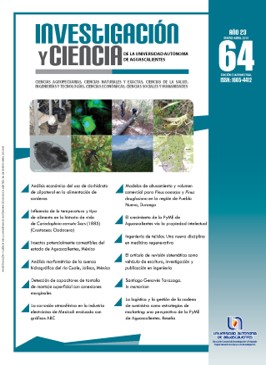El crecimiento de la PyME de Aguascalientes vía la propiedad intelectual
DOI:
https://doi.org/10.33064/iycuaa2015643596Palabras clave:
propiedad intelectual, registro de patentes, registro de marcas, crecimiento, PyMEResumen
El ambiente incierto en el que se desarrollan actualmente los negocios está obligando a las organizaciones, principalmente a las pequeñas y medianas empresas, a proteger legalmente sus patentes, marcas e imagen a través de la propiedad intelectual; lo cual puede favorecer su crecimiento y desarrollo. Este trabajo de investigación tiene como objetivo principal analizar los efectos que ejerce la protección legal de la propiedad intelectual en el crecimiento de las pequeñas y medianas empresas manufactureras del estado de Aguascalientes. El análisis empírico se llevó a cabo para una muestra de 125 empresas manufactureras de 20 a 250
trabajadores. Los resultados obtenidos indican que tanto la propiedad intelectual como el tamaño de las organizaciones tienen un impacto positivo en el crecimiento, no así en la antigüedad de las empresas.
Descargas
Citas
• DEBASIS, M. y GUPTA, R. Innovation, imitation and intellectual property rights: A note on Helpman’s model. Journal of Economics, 87(1): 29-53, 2006.
• GARCÍA, P. L. D. et al. Innovación y Cultura Empresarial de las MiPyMEs de Aguascalientes. México: Editorial UAA, 2009.
• GOULD, D. M. y GRUBEN, W. C. The role of intellectual property rights in economic growth. Journal of Development Economics, 48: 323-350, 1996.
• GROSSMAN, G. y HELPMAN, E. Innovation and Growth in the Global Economy. Cambridge, MA, USA: MIT Press, 1991.
• HELPMAN, E. Innovation, imitation, and intellectual property rights. Econometrica, 61(6): 1247-1280, 1993.
• HORII, R. e IWAISAKO, T. Economic growth with imperfect protection of intellectual property rights. Journal of Economics, 90(1): 45-85, 2007.
• HUGHES, A. Innovation and business performance: Small entrepreneurial firms in the UK and the US. New Economy, 8(3): 157-163, 2001.
• IZUSHI, H. Impact of the length of relationships upon the use of research institutes by SMEs. Research Policy, 32(3): 771-788, 2003.
• JENSEN, P. H. y WEBSTER, E. Firm size and the use of the intellectual property rights. Economic Record, 82(256): 44-55, 2006.
• JOHANNESSEN, J. A. et al. Strategic use of information technology for increased innovation and performance. Information Management and Computer Security, 7(1): 5-22, 1999.
• KANWAR, S. Innovation and intellectual property rights. Center for Development Economics, Working Paper 142. India: Delhi School of Economics, 2006.
• KRUGER, C. J. y JOHNSON, R. D. Assessment of knowledge management growth: a South Africa perspective. Aslib Proceedings: New Information Perspectives, 61(6): 542-564, 2009.
• LARSEN, E. y LOMI, A. Representing change: A system model of organizational inertia and capabilities as dynamic accumulation processes. Simulation Modelling Practice and Theory, 10: 271-296, 2002.
• LEGER, A. Intellectual property rights in Mexico: Do they play a role? World Development, 33(11): 1865-1879, 2005.
• LEGER, A. Intellectual property rights and innovation in developing countries: Evidence from panel data. Proceedings of the German
Development Economics Conference, Berlin. 2006.
• LINDER, J. C. Does innovation drive profitable growth? New metrics for a complete picture. Journal of Business Strategy, 27(5): 38-44, 2006.
• LLOYD, W. F. Intellectual property rights & associated challenges for small business. Journal of Business and Entrepreneurship, 7(2): 93-102, 1995.
• McLENNAN, P. G. y LE, Q. V. The effects of intellectual property rights violation on economic growth. Modern Economy, 12: 107-113, 2011.
• MOKYR, J. Intellectual property rights, the industrial revolution and the beginning of modern economy growth. American Economic Review: Papers & Proceedings, 99(2): 349-355, 2009.
• MORGAN, E. J. y FAI, F. M. Innovation, competition and change in international business: Emergent research trajectories. Management International Review, 47(5): 631-638, 2007.
• NISAR, T. M. Intellectual property securitization and growth capital in retail franchising. Journal of Retailing, 87(3): 393-405, 2011.
• PÄÄLLYSAHO, S. y KUUSISTA, J. Informal ways to protect intellectual property (IP) in KIBS business. Innovation: Management, Policy & Practice, 36: 62-76, 2011.
• PALLAB, P. y MUKHOPADHYAY, K. Growth via intellectual property rights versus gendered inequity in emerging economies: An ethical dilemma for international business. Journal of Business Ethics, 91(3): 359-378, 2010.
• PARK, W. G. y GINARTE, J. C. Intellectual property rights and economic growth. Contemporary Economic Policy, 15(3): 51-61, 1997.
• QIU, L. D. y YU, H. Does the protection of foreign intellectual property rights stimulate innovation in the US? Review of International Economics, 18(5): 882-895, 2010.
• ROMER, P. Endogenous growth and technical change. Journal of Political Economy, 99: 807-827, 2006.
• SALOJÄRVI, S. et al. Knowledge management and growth in Finnish SMEs. Journal of Knowledge Management, 9(2): 103-122, 2005.
• SAMBAMURTHY, V. et al. Shaping agility through digital options: Reconceptualising the role of information technology in contemporary firms. MIS Quarterly, 27(2): 237-263, 2003.
• SMITH, B. L. y MANN, S. O. Innovation and intellectual property protection in the software industry: An emerging role of patents. The University of Chicago Law Review, 71(1): 241-264, 2004.
• SOMAYA, D. et al. Innovation in multi-invention contexts: Mapping solutions to technological and intellectual property complexity. California Management Review, 53(4): 47-79, 2011.
• TANABE, K. y WATANBE, C. Sources of small and medium enterprises excellent business performance in a service orientated economy.
Journal of Service Research, 5(1): 5-20, 2005.
• TAYLOR, S. Trips, trade and growth. International Economic Review, 35(2): 361-381, 1994.
• WIPO (WORLD INTERNATIONAL PROPERTY ORGANIZATION). WIPO survey of intellectual property services of European technology
incubators. Geneva, Italy: Mimeo, 2003.
• XIANG, D. C. y LAN, S. F. IT adoption in manufacturing industries: Differences by company size and industrial sectors: The case of Chinese mechanical industries. Technovation, 21(11): 649-660, 2001.
Descargas
Publicado
Cómo citar
Licencia
Derechos de autor 2015 Sandra Yesenia Pinzón Castro, Gonzalo Maldonado Guzmán, María del Carmen Martínez Serna, Ricardo García-Ramírez

Esta obra está bajo una licencia internacional Creative Commons Atribución-NoComercial-CompartirIgual 4.0.
Las obras publicadas en versión electrónica de la revista están bajo la licencia Creative Commons Atribución-NoComercial-CompartirIgual 4.0 Internacional (CC BY-NC-SA 4.0)









